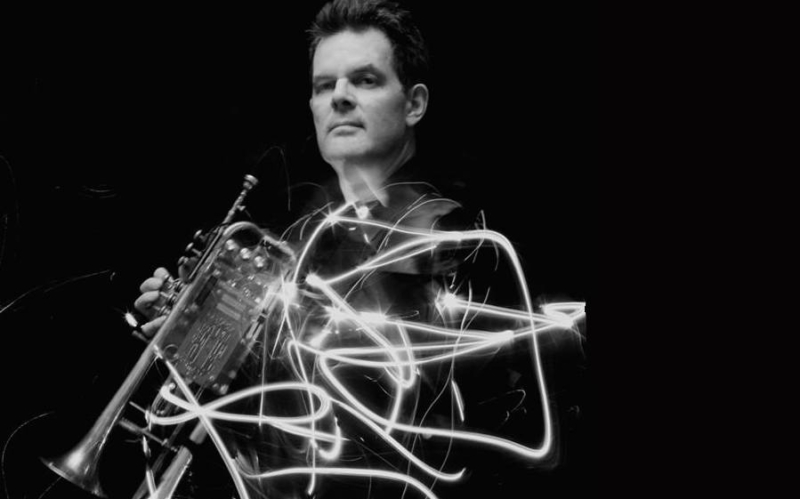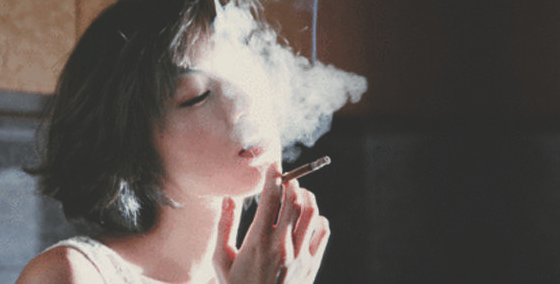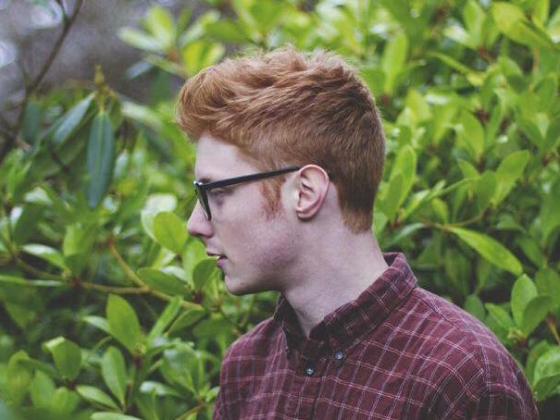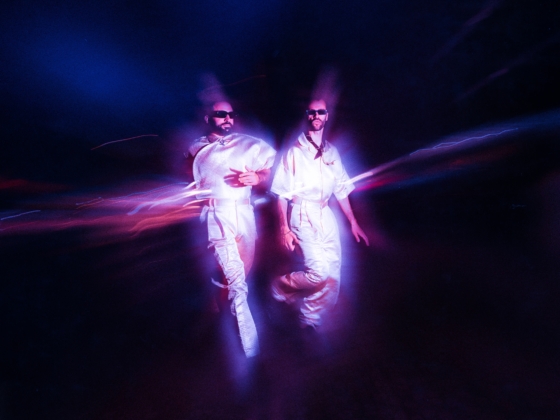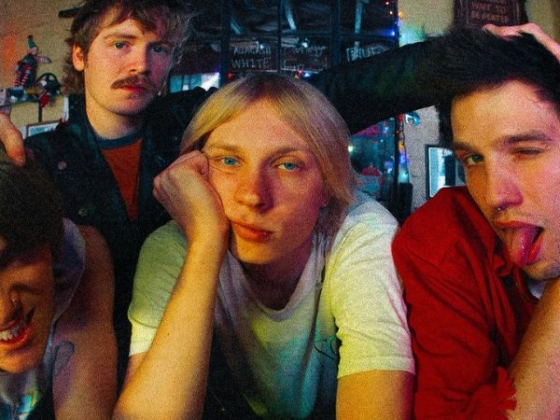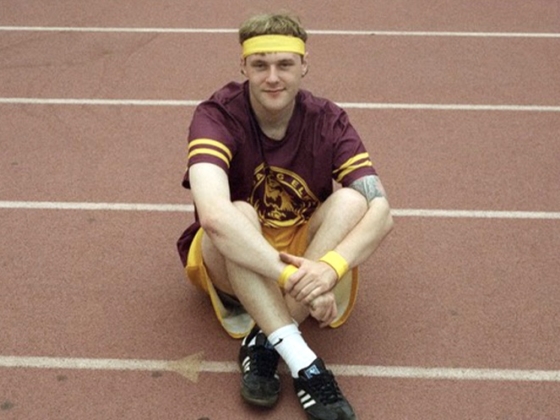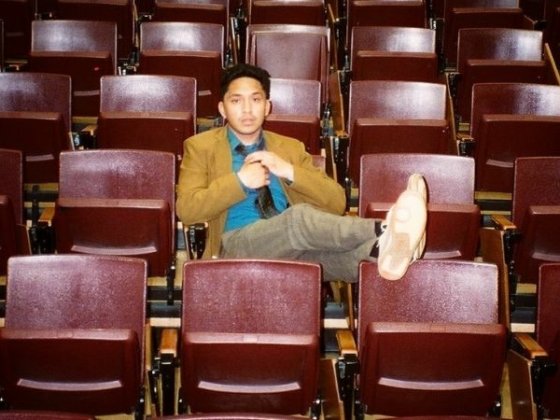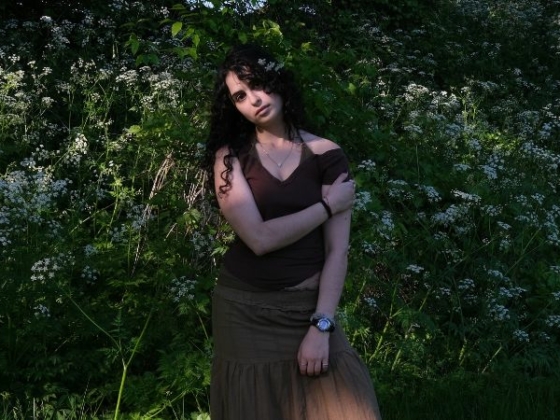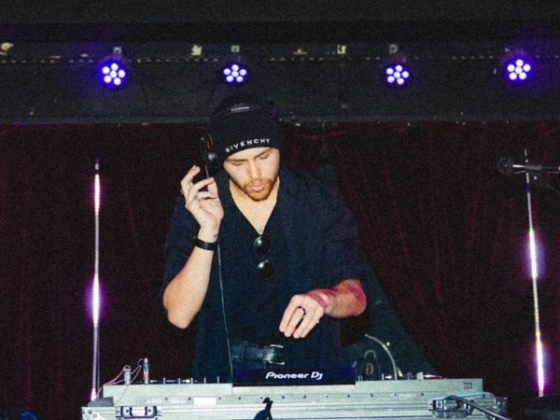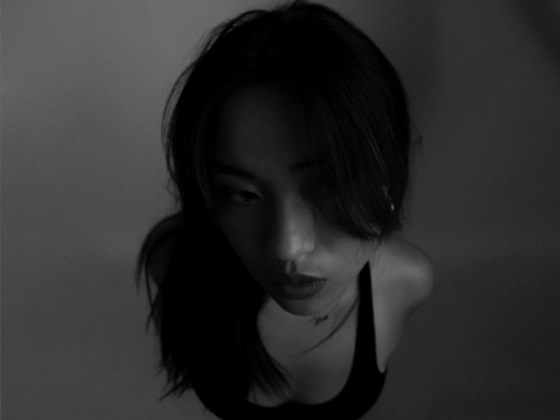Upon first glance, the most remarkable thing about Ben Neill is the odd-looking trumpet that hangs at his side. The ‘mutantrumpet’ – as it’s known both affectionately and professionally – is a three-pronged, hybrid electro-acoustic instrument, and he’s been lugging its various iterations around the world for over 30 years.
The mutantrumpet was originally designed with Robert Moog (yes, that Robert Moog) and it’s steadily evolved into a proverbial electronic command center. In performances, Neill can now manipulate Ableton Live via two Macbooks from his trumpet while simultaneously playing any one of its distinct bells and feeding that sound back into the system; it’s a fascinatingly complex dialogue between performer and machine.
I was there when he premiered his new album, Horizonal, last week at New York City’s Pianos, so I can personally attest to Neill's mindbending balancing act that allows him to create, process and warp sounds on the fly. He was constantly messing with knobs and cues and both “real” and electronically processed sounds to cast lush, cinematic, and at times frenetic, soundscapes throughout the small venue.
[soundcloud url="https://api.soundcloud.com/playlists/147952825" params="auto_play=false&hide_related=false&show_comments=true&show_user=true&show_reposts=false&visual=true" width="100%" height="250" iframe="true" /]
The performance featured guitarist Gary Lucas (of Captain Beefheart fame), as well as expressive vocalist Mimi Goese, and it prompted the proceeding band, Telekinetic Walrus – an experimental collective self-described as a “funky, psychedelic hip-hop and electronic experience” – to say, “I’ve never seen shit like that before.”
After the show, Neill took the time to talk with us about his music, his infamous trumpet and a career that has brushed up against seemingly every luminary in the history of electronic music. Moog was just the beginning…
EARMILK: Was the trumpet your first instrument?
Ben Neill: Not really, I actually kinda started on piano and guitar first, but trumpet was the instrument that I got seriously about. I’m from North Carolina, and I started studying at the North Carolina School of the Arts, which was a pretty cool conservatory program. So yeah, it’s the instrument that I really put most of my energy into.
EM: So when did that transition happen when you decided you wanted to use the trumpet as an electronic instrument?
BN: I spent quite a bit of time studying classical trumpet, and while I was in undergrad I started taking some orchestra auditions. I had grown up listening to all different kinds of music, like the music that I was really the most passionate about was like art rock: Brian Eno, David Bowie…and I was also into ECM jazz: Keith Jarret, Jan Garbarek, that kind of stuff. After I took a few of these orchestra auditions, I was thinking, ‘this isn’t really what I want to do with music’. I want to have a more creative role in music, and I was very influenced by Stockhausen’s writings. He wrote a lot of things about how instruments needed to be augmented with electronics and expanded, and John Cage was also a big influence on me. I played a lot of his music.
So, around the early ‘80s I started getting this idea to create my own instrument, a vehicle for my own composer/performer project. A lot of what goes on in contemporary music for brass is using different mutes to change the color and timbre of the sound, so I thought, ‘what if I had more than one bell?' so I could do a smooth transition from an open sound to a muted sound, or two different muted sounds, and I was also thinking about a slide…a true slide like a trombone, and quartertones.
I happened to know this guy that had worked at the King Instrument Factory and we just started experimenting by sticking parts together, and then I approached Robert Moog. After he sold his interest in the Moog company, he put an ad in the back of Keyboard Magazine—this was in the 1980’s—‘Robert Moog is accepting custom project proposals’ or whatever. So I wrote to him and he got really interested in the whole thing and developed an analog—this is pre-midi—pitch-to-voltage converter system with a modular synthesizer for it and then it just kind of took off from there.
I was going to school at Youngstown State in Ohio then and I was really involved in the punk/new wave scene in Akron and Cleveland, and that was where I first started using it a lot, in these different new wave bands. And then I also used it to play pieces of Cage and Stockhausen and stuff like that, but then I gradually started to develop my own approach to making my own music with it.
EM: You studied with La Monte Young, too, right? Where did that fit in?
BN: Yes I worked with La Monte Young a lot. But the person that was really the key person in my whole history was Jon Hassell, who is a trumpet player/composer that did several records with Brian Eno, and when I first moved to New York in 1983, I got in touch with him through his record label and he basically took me on – not really as a student, but he acted as kind of a mentor to me. He introduced me to La Monte Young and Rhys Chatham – a lot of the people that I ended up working with, and La Monte did take students, so I worked with him very closely all through the ‘80s and now I’m working with him again. So he was a big influence on me, La Monte.
EM: Was that your first foray into minimalism? Or had you already been leaning in that direction?
BN: I always really tended toward minimal reductionist music. I was very attracted to it just instinctively. But working with La Monte really gave me a different kind of understanding of tuning and harmonics, of how pure tuning works, just intonation, frequency ratios… La Monte really introduced me to a much deeper understanding of that. And I was already really interested in minimal music: Terry Riley and Philip Glass and Steve Reich, and also then Brian Eno and David Bowie…there was a lot of crossover in that.
EM: Yeah that was actually my next question. La Monte Young and Brian Eno… those are two guys that are sort of right in the middle, where they influence a lot of popular musicians from the art music side. And it seems like that idea has sort of snowballed throughout the last 30 years, like we’re in this fluctuating stasis of all these ideas where people are borrowing from each other, just putting things together in different ways. I’m curious about what you think about the music landscape now and how it relates to how it was then?
BN: Well I think minimalism is the most important musical idea by far of the last half of the 20th century. La Monte likes to talk about how he changed the course of western music, and if you look at where music was in the ‘50s – both art music and jazz – they were both kind of obsessed with technique, this hyper information kind of music that was very inaccessible for many people. And there’s that famous quote of Milton Babbitt: “who cares if they listen?” and all that… But I’m not absolutely sure what you’re asking, so you’re saying basically that you think Eno and La Monte’s ideas are just kind of constantly being recycled, or repeated…
EM: Well, up until that point, it didn’t really feel like art music and popular music converged, and since then it feels like they’ve converged a lot and they’ve overlapped in all these different small niches.
BN: Yeah I think that’s true, and that’s always been my artistic project. I don’t actually think the art/pop convergence is maybe quite as much of a done deal as we all think it is. I mean we all think of post-modernism as being this complete flattening of everything, but I’ll be honest, that’s something that I’ve struggled with, because I really have embraced that. I came out of the avant-garde world; I was involved with minimalism in the ‘80s. I was not part of the free improv scene; I dislike free music, I’m not into free music at all. I mean the mutantrumpet could have been a great vehicle for that music, but it just wasn’t what I wanted to do.
For me the idea of composition and making my own music – and also working with technology – is to do something that takes me to a place where I didn’t expect to go. I wanted to do something that was more conceptual… I think Eno is a very important figure; he’s the person that articulated that better than anybody else. He brought the art music ideas into popular music and he continues to do that in the greatest way. La Monte did that through his influence; he’s done some projects that were a bit more oriented toward that, but his own music, like this piece that I’m involved in now, is extremely austere and is still challenging for some people.
I worked on a project with a scientist, and I’m working on another thing with a mathematician, so I’m interested a lot in math and science and La Monte’s thing is very mathematical. There’s this thing called Occam's Razor, where you know, the simplest solution to any problem is the best. Eno talks about that; minimal music is kind of all about that: if you take simple elements and you put them in combination in the right way, you get something out of it that’s much bigger than what you started with.
And I think that’s a really important idea, that kind of simplicity, especially today in a world where there’s so much overload, and I think that kind of reductionist approach… you see it everywhere. Look at Drake’s new video, he sampled James Turrell, one of the great minimal artists. You know Beck’s album was very much that way, tons of empty space. I’ve always been attracted that, but I find that in this day and time I’m even more attracted to that. Something where someone has a very clear idea and it’s presented in a way with a lot of space around it; that’s something that I try to do.
EM: So how do you approach composition in regard to that – when you’re composing a song, are you putting things into a system, and then as things come out, do you record them? Is your trumpet the main thing you compose on, or do you compose a melody on a piano or something?
BN: It’s always changing, but I mean the trumpet is always a big part of it… A lot of what I’m doing is grabbing my sound on the fly, but instead of just looping it, I’m actually sampling it. So that then, as soon as I play something, I press a switch on the trumpet, then it grabs it and then I have these presets so that when I play other notes, it starts to play back the sample that I made and then I can modify it on the fly. So, I spend a lot of time improvising with the live sampling system, and finding things that resonate and work and then I build my compositions around that. I use a lot of structures that are based on harmonics and overtones.
I’ve become looser in my approach to composing, and this is the first record I’ve ever done where I really made the whole record in [Ableton] Live. I made it as a live set, and then I brought it back into Logic. Like I said, I’m not really into free music, but as I’ve gotten more and more into this whole interactive electronic performance, I do think there needs to be an element of improvisation, because interactivity implies improvisation. You want to be able to play with the thing, and give space for that, and also give space if it fucks up, and it always does.
EM: Cool, so tangentially, after La Monte Young – and you mentioned his influence and how important that was… how has that compositional stream continued? Who in your mind are some of the more influential musicians or artists in the ‘90s, the 2000’s, today…?
BN: You know for me, the early ‘90s ambient electronica – The Future Sound of London, Aphex Twin, The Orb, all that British electronica, and then I worked really closely with DJ Spooky. I would say Future Sound of London… I found them to be the most adventurous as far as really pushing the limits of that whole thing that you’re talking about with popular music and art music converging. They use these very complex textures and unpredictable sounds but with grooves; those were really influential on me.
Later, I was really involved when Dubstep first started in New York. I really liked a lot of the UK Dub: HyperDub, Code 9, Burial, Appleblim, all the Bristols, Pinch… Pinch remixed one of my songs from Night Science and I was actually just with him in Berlin a few weeks ago when he was DJ'ing. And more recently I’ve been into slower deep house stuff: Maya Jane Coles, some of the artists on this label that I’m on, Audiokult.
Drum and Bass was also really important for me in the ‘90s. A lot of the new music I’m doing with Mimi is in the drum and bass vibe. I kind of feel drum and bass coming back a little bit. In a lot of ways I feel like it was the most adventurous electronic music. I was just in London, I was hearing it in the air a little bit.
EM: You also curated at The Kitchen for a long time right? Was that influential to your music?
BN: Yep, I was there for eight years in the ‘90s. I presented a lot of these kinds of events where I would mix DJ’s with a lot of younger electronic artists with like John Cage and older minimal music. I think that’s important for any artist to kind of be at the center of a scene, be able to present different people.
I had a record deal with Astralwerks, and I did two records with Verge during that time. And I did continue to do some curating down at the World Financial Center at Winter Garden. I presented M83 down there, Ulrich Schnauss, Code 9… we did a lot of great shows down there, too. Curating is – I mean Eno talks about that – curating is not that far from being an artist.
EM: Absolutely! So what’s next? You’ve done a lot.
BN: Well I’m working on this new music with Mimi and where we’re coming from with that is, I’ve been collaborating long distance with this mathematician Ralph Abraham; he’s out in Santa Cruz and works with fractal mathematics. He runs this thing at UC Santa Cruz called The Visual Math Institute where they basically are realizing fractals in both animation and sound. I met Ralph in 2012 and we’ve been developing an approach on how we’re going to collaborate…with La Monte – you know there’s a lot of math in his music – it’s all very simple math, [but] with Ralph it’s very complex mathematics. He uses this program called Matlab, and it’s like hundreds of thousands of numbers just to generate a little 15-second animation with a sound or an image or something. And then we’re basically sampling that and then using that as a basis for writing these songs where the lyrics are also kind of about mathematics and mysticism.
[Abraham] is not a conventional mathematician, he’s a philosopher. He’s written a lot of books that are kind of about the mystical, psychedelic aspects of mathematic; he worked a lot with Terrence McKenna… who I was also friends with. We were planning a collaboration before he passed away, so in some ways I feel like this project with Ralph is in some ways picking up on a project that I never got to do with Terrence.
So that’s kind of the next project. It feels very organic; it’s kind of growing out of this record and the music I just did. I’m also developing another piece that is slightly more theatrical. It’s based on Girolamo Fantini – he wrote the first method book for trumpet back in the 1630s and he was the first person to be able to play the trumpet indoors. I’m doing a kind of remix of some of his music with a baroque organist and we’re trying to take it into a 21st century virtual reality realm.
I’ve also done a couple of these operas…based on Douglas Engelbart, the computer science pioneer. So you’re mentioning the whole thing about the art music and the popular music; I still find that I have to have a range of different projects because I can’t necessarily present the same thing at an art music concert hall that I would at Pianos or at [New York venue] Le Poisson Rouge.
EM: Definitely. Well that's about all I've got – thanks for your time Ben, really appreciate it!
And so we parted ways. Keep your ears open for more Ben Neill – mutant trumpeter and electronic pioneer – as he bravely navigates music, mysticism, math and the turbulent, quasi-flat waters of post-modernism.

